Toyota's Success Through Scientific Management: A Case Study
VerifiedAdded on 2023/05/30
|9
|2189
|365
Essay
AI Summary
This essay examines Toyota's implementation of scientific management principles, tracing its evolution from a small company to a global automotive leader. It highlights Toyota's production system (Toyotism) and the Just-in-Time approach, pioneered by Taiichi Ohno, as key elements of its success. The analysis covers Toyota's approach to product development, production preparation, and manufacturing processes, emphasizing innovation, teamwork, and employee-friendly production lines. The essay also addresses how Toyota applies scientific management principles through task specialization, division of labor, and hierarchical control, while also acknowledging the potential for dehumanization of employees. Ultimately, it argues that Toyota's ability to integrate scientific management with its unique production system has enabled it to achieve superior quality, efficiency, and responsiveness to customer needs, making it a model for other companies worldwide. Desklib provides access to similar solved assignments and resources for students.

SCIENTIFIC MANAGEMENT BY TOYOTA 1
Scientific management by Toyota
Name
Course
Tutor
University
City/State
Date
Scientific management by Toyota
Name
Course
Tutor
University
City/State
Date
Secure Best Marks with AI Grader
Need help grading? Try our AI Grader for instant feedback on your assignments.
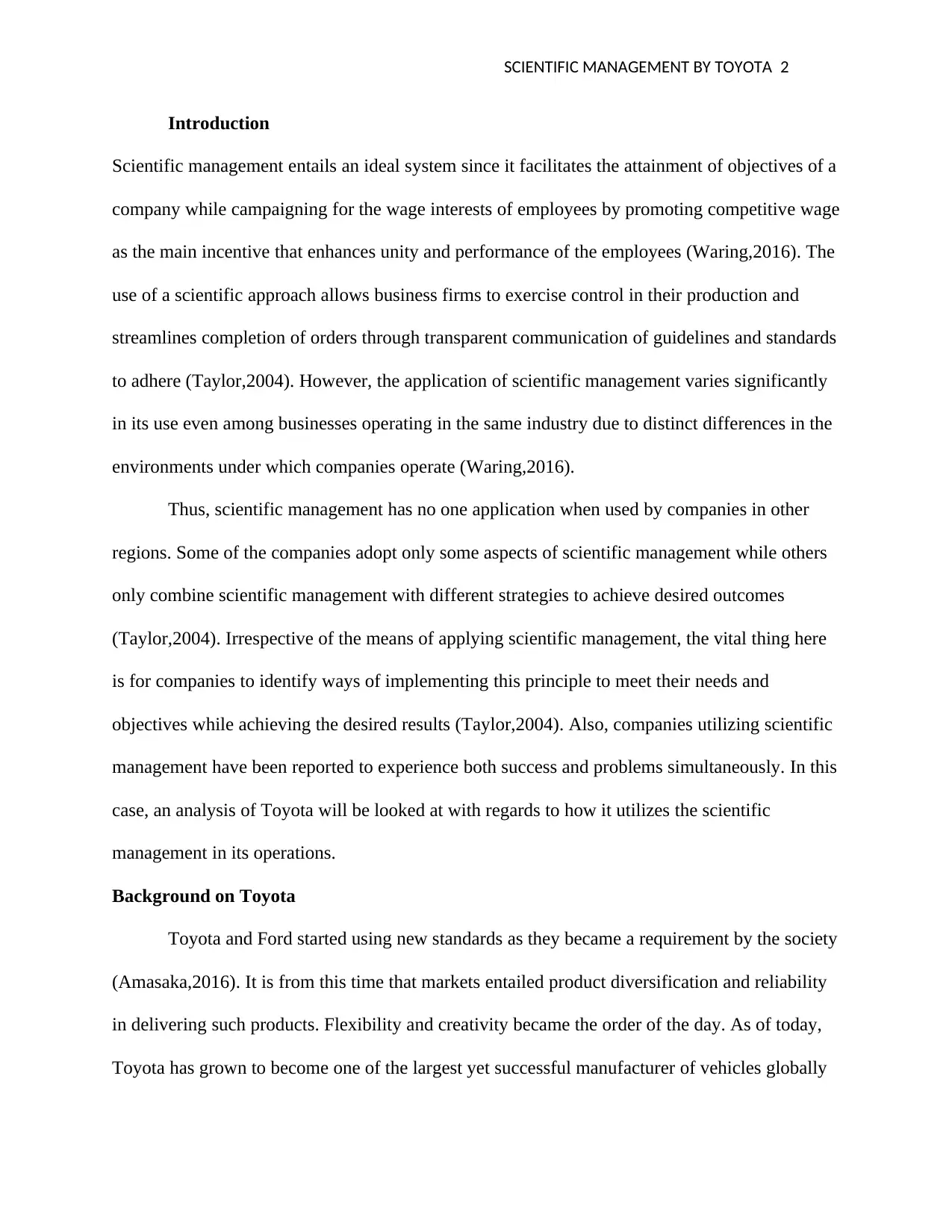
SCIENTIFIC MANAGEMENT BY TOYOTA 2
Introduction
Scientific management entails an ideal system since it facilitates the attainment of objectives of a
company while campaigning for the wage interests of employees by promoting competitive wage
as the main incentive that enhances unity and performance of the employees (Waring,2016). The
use of a scientific approach allows business firms to exercise control in their production and
streamlines completion of orders through transparent communication of guidelines and standards
to adhere (Taylor,2004). However, the application of scientific management varies significantly
in its use even among businesses operating in the same industry due to distinct differences in the
environments under which companies operate (Waring,2016).
Thus, scientific management has no one application when used by companies in other
regions. Some of the companies adopt only some aspects of scientific management while others
only combine scientific management with different strategies to achieve desired outcomes
(Taylor,2004). Irrespective of the means of applying scientific management, the vital thing here
is for companies to identify ways of implementing this principle to meet their needs and
objectives while achieving the desired results (Taylor,2004). Also, companies utilizing scientific
management have been reported to experience both success and problems simultaneously. In this
case, an analysis of Toyota will be looked at with regards to how it utilizes the scientific
management in its operations.
Background on Toyota
Toyota and Ford started using new standards as they became a requirement by the society
(Amasaka,2016). It is from this time that markets entailed product diversification and reliability
in delivering such products. Flexibility and creativity became the order of the day. As of today,
Toyota has grown to become one of the largest yet successful manufacturer of vehicles globally
Introduction
Scientific management entails an ideal system since it facilitates the attainment of objectives of a
company while campaigning for the wage interests of employees by promoting competitive wage
as the main incentive that enhances unity and performance of the employees (Waring,2016). The
use of a scientific approach allows business firms to exercise control in their production and
streamlines completion of orders through transparent communication of guidelines and standards
to adhere (Taylor,2004). However, the application of scientific management varies significantly
in its use even among businesses operating in the same industry due to distinct differences in the
environments under which companies operate (Waring,2016).
Thus, scientific management has no one application when used by companies in other
regions. Some of the companies adopt only some aspects of scientific management while others
only combine scientific management with different strategies to achieve desired outcomes
(Taylor,2004). Irrespective of the means of applying scientific management, the vital thing here
is for companies to identify ways of implementing this principle to meet their needs and
objectives while achieving the desired results (Taylor,2004). Also, companies utilizing scientific
management have been reported to experience both success and problems simultaneously. In this
case, an analysis of Toyota will be looked at with regards to how it utilizes the scientific
management in its operations.
Background on Toyota
Toyota and Ford started using new standards as they became a requirement by the society
(Amasaka,2016). It is from this time that markets entailed product diversification and reliability
in delivering such products. Flexibility and creativity became the order of the day. As of today,
Toyota has grown to become one of the largest yet successful manufacturer of vehicles globally
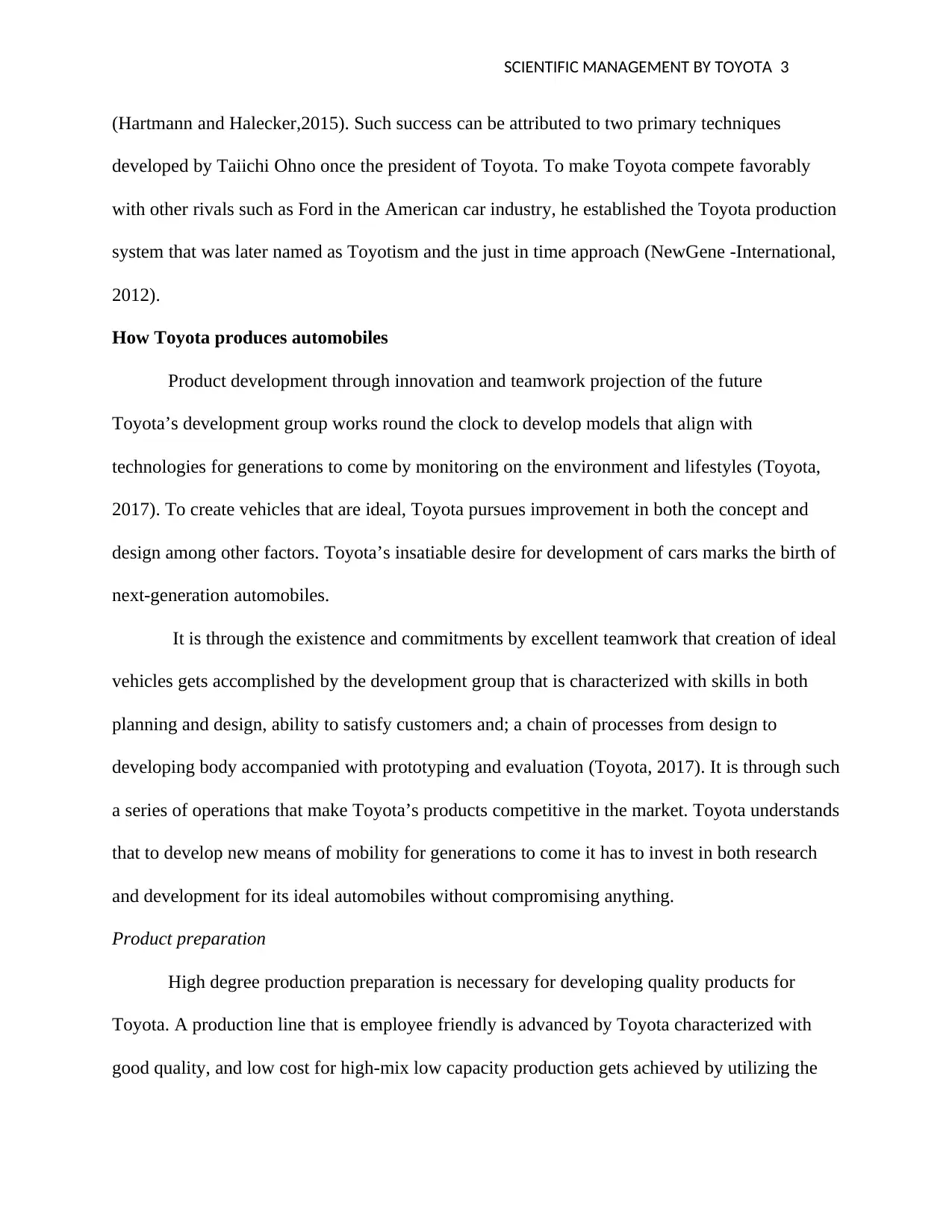
SCIENTIFIC MANAGEMENT BY TOYOTA 3
(Hartmann and Halecker,2015). Such success can be attributed to two primary techniques
developed by Taiichi Ohno once the president of Toyota. To make Toyota compete favorably
with other rivals such as Ford in the American car industry, he established the Toyota production
system that was later named as Toyotism and the just in time approach (NewGene -International,
2012).
How Toyota produces automobiles
Product development through innovation and teamwork projection of the future
Toyota’s development group works round the clock to develop models that align with
technologies for generations to come by monitoring on the environment and lifestyles (Toyota,
2017). To create vehicles that are ideal, Toyota pursues improvement in both the concept and
design among other factors. Toyota’s insatiable desire for development of cars marks the birth of
next-generation automobiles.
It is through the existence and commitments by excellent teamwork that creation of ideal
vehicles gets accomplished by the development group that is characterized with skills in both
planning and design, ability to satisfy customers and; a chain of processes from design to
developing body accompanied with prototyping and evaluation (Toyota, 2017). It is through such
a series of operations that make Toyota’s products competitive in the market. Toyota understands
that to develop new means of mobility for generations to come it has to invest in both research
and development for its ideal automobiles without compromising anything.
Product preparation
High degree production preparation is necessary for developing quality products for
Toyota. A production line that is employee friendly is advanced by Toyota characterized with
good quality, and low cost for high-mix low capacity production gets achieved by utilizing the
(Hartmann and Halecker,2015). Such success can be attributed to two primary techniques
developed by Taiichi Ohno once the president of Toyota. To make Toyota compete favorably
with other rivals such as Ford in the American car industry, he established the Toyota production
system that was later named as Toyotism and the just in time approach (NewGene -International,
2012).
How Toyota produces automobiles
Product development through innovation and teamwork projection of the future
Toyota’s development group works round the clock to develop models that align with
technologies for generations to come by monitoring on the environment and lifestyles (Toyota,
2017). To create vehicles that are ideal, Toyota pursues improvement in both the concept and
design among other factors. Toyota’s insatiable desire for development of cars marks the birth of
next-generation automobiles.
It is through the existence and commitments by excellent teamwork that creation of ideal
vehicles gets accomplished by the development group that is characterized with skills in both
planning and design, ability to satisfy customers and; a chain of processes from design to
developing body accompanied with prototyping and evaluation (Toyota, 2017). It is through such
a series of operations that make Toyota’s products competitive in the market. Toyota understands
that to develop new means of mobility for generations to come it has to invest in both research
and development for its ideal automobiles without compromising anything.
Product preparation
High degree production preparation is necessary for developing quality products for
Toyota. A production line that is employee friendly is advanced by Toyota characterized with
good quality, and low cost for high-mix low capacity production gets achieved by utilizing the
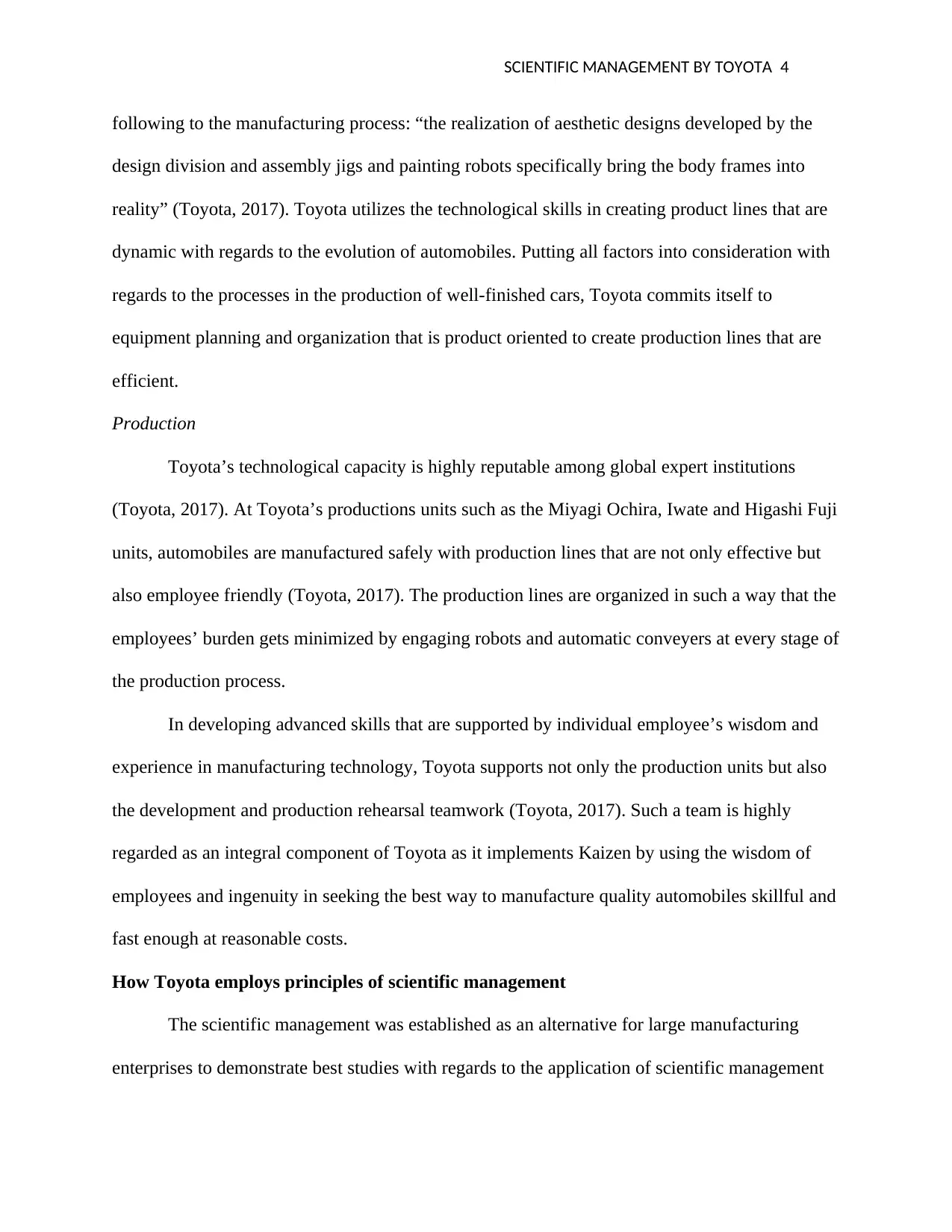
SCIENTIFIC MANAGEMENT BY TOYOTA 4
following to the manufacturing process: “the realization of aesthetic designs developed by the
design division and assembly jigs and painting robots specifically bring the body frames into
reality” (Toyota, 2017). Toyota utilizes the technological skills in creating product lines that are
dynamic with regards to the evolution of automobiles. Putting all factors into consideration with
regards to the processes in the production of well-finished cars, Toyota commits itself to
equipment planning and organization that is product oriented to create production lines that are
efficient.
Production
Toyota’s technological capacity is highly reputable among global expert institutions
(Toyota, 2017). At Toyota’s productions units such as the Miyagi Ochira, Iwate and Higashi Fuji
units, automobiles are manufactured safely with production lines that are not only effective but
also employee friendly (Toyota, 2017). The production lines are organized in such a way that the
employees’ burden gets minimized by engaging robots and automatic conveyers at every stage of
the production process.
In developing advanced skills that are supported by individual employee’s wisdom and
experience in manufacturing technology, Toyota supports not only the production units but also
the development and production rehearsal teamwork (Toyota, 2017). Such a team is highly
regarded as an integral component of Toyota as it implements Kaizen by using the wisdom of
employees and ingenuity in seeking the best way to manufacture quality automobiles skillful and
fast enough at reasonable costs.
How Toyota employs principles of scientific management
The scientific management was established as an alternative for large manufacturing
enterprises to demonstrate best studies with regards to the application of scientific management
following to the manufacturing process: “the realization of aesthetic designs developed by the
design division and assembly jigs and painting robots specifically bring the body frames into
reality” (Toyota, 2017). Toyota utilizes the technological skills in creating product lines that are
dynamic with regards to the evolution of automobiles. Putting all factors into consideration with
regards to the processes in the production of well-finished cars, Toyota commits itself to
equipment planning and organization that is product oriented to create production lines that are
efficient.
Production
Toyota’s technological capacity is highly reputable among global expert institutions
(Toyota, 2017). At Toyota’s productions units such as the Miyagi Ochira, Iwate and Higashi Fuji
units, automobiles are manufactured safely with production lines that are not only effective but
also employee friendly (Toyota, 2017). The production lines are organized in such a way that the
employees’ burden gets minimized by engaging robots and automatic conveyers at every stage of
the production process.
In developing advanced skills that are supported by individual employee’s wisdom and
experience in manufacturing technology, Toyota supports not only the production units but also
the development and production rehearsal teamwork (Toyota, 2017). Such a team is highly
regarded as an integral component of Toyota as it implements Kaizen by using the wisdom of
employees and ingenuity in seeking the best way to manufacture quality automobiles skillful and
fast enough at reasonable costs.
How Toyota employs principles of scientific management
The scientific management was established as an alternative for large manufacturing
enterprises to demonstrate best studies with regards to the application of scientific management
Secure Best Marks with AI Grader
Need help grading? Try our AI Grader for instant feedback on your assignments.
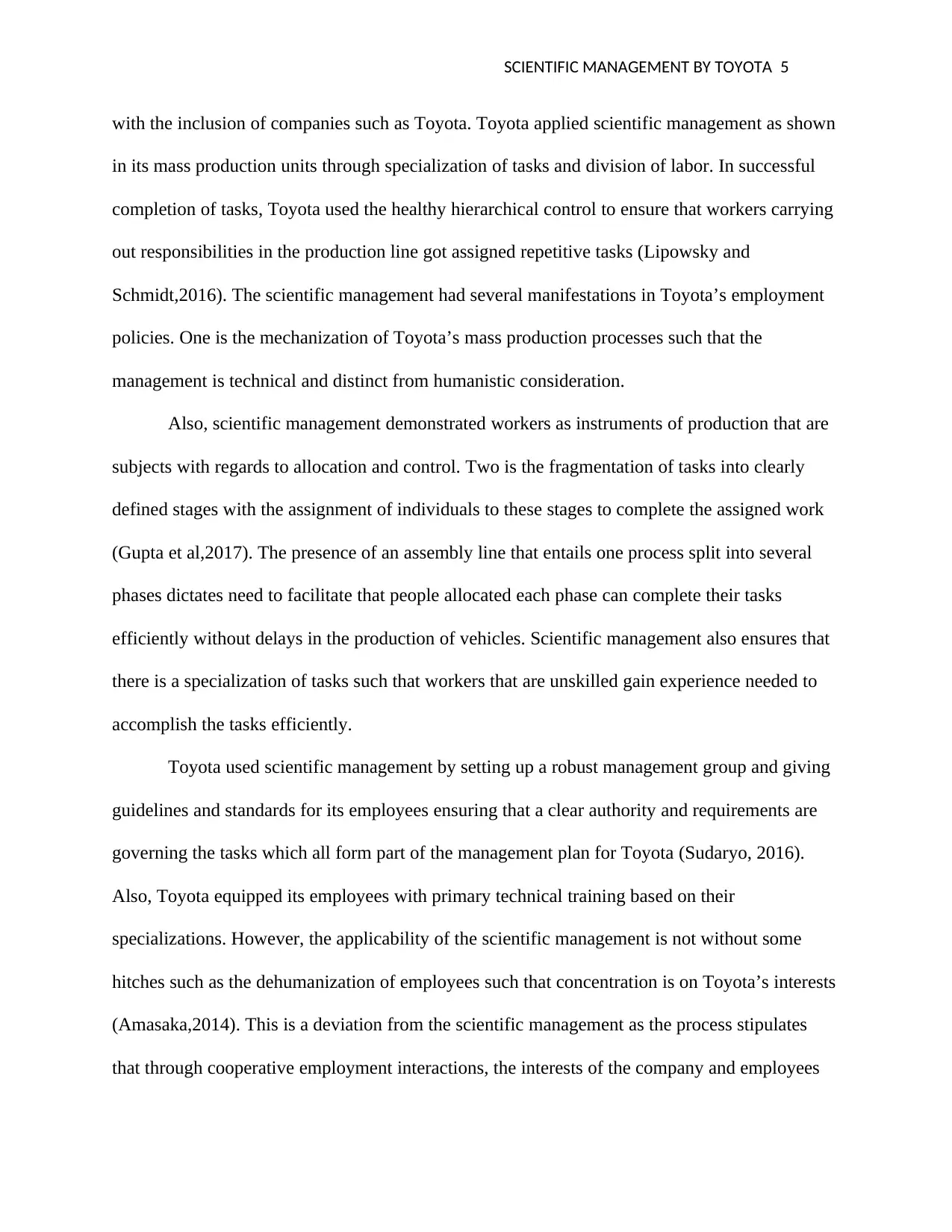
SCIENTIFIC MANAGEMENT BY TOYOTA 5
with the inclusion of companies such as Toyota. Toyota applied scientific management as shown
in its mass production units through specialization of tasks and division of labor. In successful
completion of tasks, Toyota used the healthy hierarchical control to ensure that workers carrying
out responsibilities in the production line got assigned repetitive tasks (Lipowsky and
Schmidt,2016). The scientific management had several manifestations in Toyota’s employment
policies. One is the mechanization of Toyota’s mass production processes such that the
management is technical and distinct from humanistic consideration.
Also, scientific management demonstrated workers as instruments of production that are
subjects with regards to allocation and control. Two is the fragmentation of tasks into clearly
defined stages with the assignment of individuals to these stages to complete the assigned work
(Gupta et al,2017). The presence of an assembly line that entails one process split into several
phases dictates need to facilitate that people allocated each phase can complete their tasks
efficiently without delays in the production of vehicles. Scientific management also ensures that
there is a specialization of tasks such that workers that are unskilled gain experience needed to
accomplish the tasks efficiently.
Toyota used scientific management by setting up a robust management group and giving
guidelines and standards for its employees ensuring that a clear authority and requirements are
governing the tasks which all form part of the management plan for Toyota (Sudaryo, 2016).
Also, Toyota equipped its employees with primary technical training based on their
specializations. However, the applicability of the scientific management is not without some
hitches such as the dehumanization of employees such that concentration is on Toyota’s interests
(Amasaka,2014). This is a deviation from the scientific management as the process stipulates
that through cooperative employment interactions, the interests of the company and employees
with the inclusion of companies such as Toyota. Toyota applied scientific management as shown
in its mass production units through specialization of tasks and division of labor. In successful
completion of tasks, Toyota used the healthy hierarchical control to ensure that workers carrying
out responsibilities in the production line got assigned repetitive tasks (Lipowsky and
Schmidt,2016). The scientific management had several manifestations in Toyota’s employment
policies. One is the mechanization of Toyota’s mass production processes such that the
management is technical and distinct from humanistic consideration.
Also, scientific management demonstrated workers as instruments of production that are
subjects with regards to allocation and control. Two is the fragmentation of tasks into clearly
defined stages with the assignment of individuals to these stages to complete the assigned work
(Gupta et al,2017). The presence of an assembly line that entails one process split into several
phases dictates need to facilitate that people allocated each phase can complete their tasks
efficiently without delays in the production of vehicles. Scientific management also ensures that
there is a specialization of tasks such that workers that are unskilled gain experience needed to
accomplish the tasks efficiently.
Toyota used scientific management by setting up a robust management group and giving
guidelines and standards for its employees ensuring that a clear authority and requirements are
governing the tasks which all form part of the management plan for Toyota (Sudaryo, 2016).
Also, Toyota equipped its employees with primary technical training based on their
specializations. However, the applicability of the scientific management is not without some
hitches such as the dehumanization of employees such that concentration is on Toyota’s interests
(Amasaka,2014). This is a deviation from the scientific management as the process stipulates
that through cooperative employment interactions, the interests of the company and employees
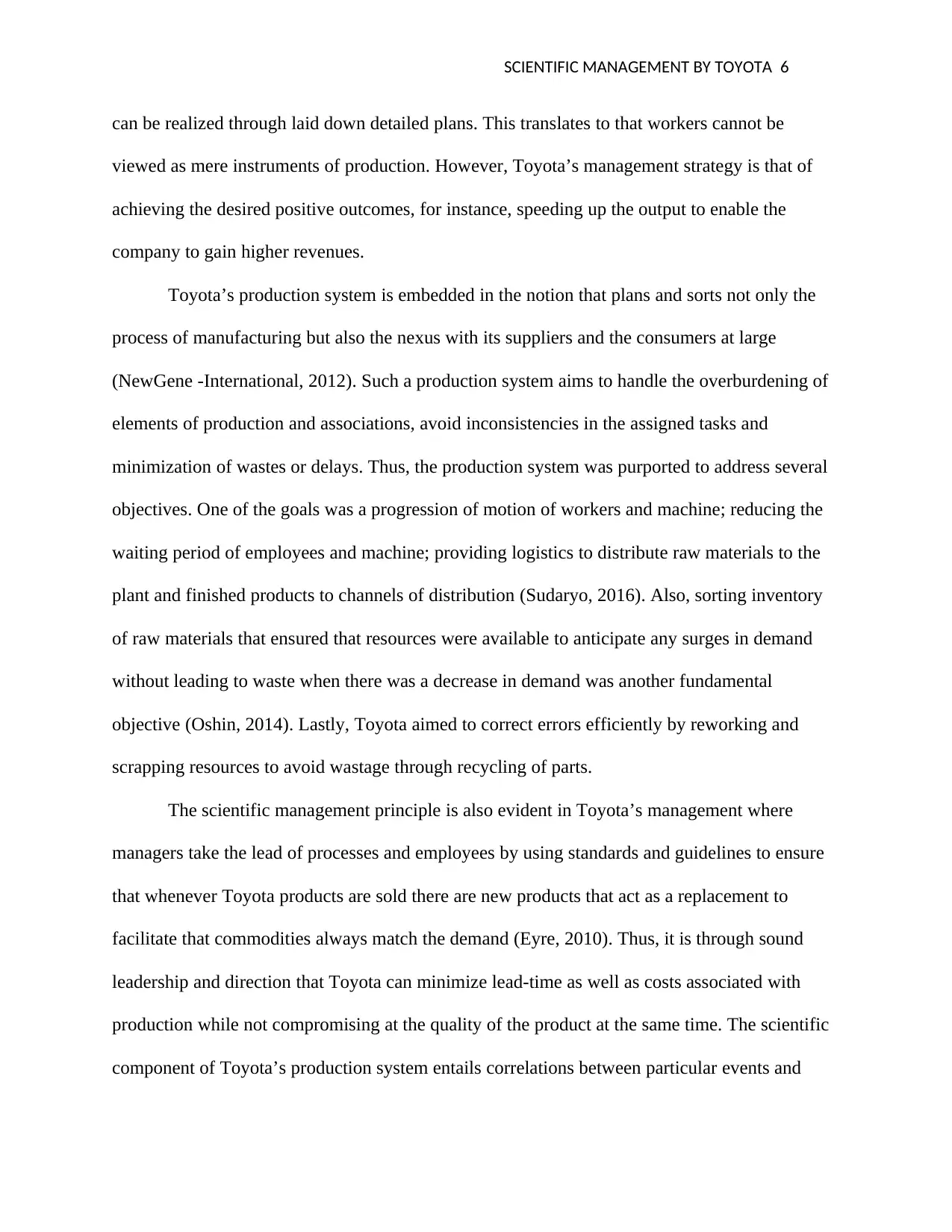
SCIENTIFIC MANAGEMENT BY TOYOTA 6
can be realized through laid down detailed plans. This translates to that workers cannot be
viewed as mere instruments of production. However, Toyota’s management strategy is that of
achieving the desired positive outcomes, for instance, speeding up the output to enable the
company to gain higher revenues.
Toyota’s production system is embedded in the notion that plans and sorts not only the
process of manufacturing but also the nexus with its suppliers and the consumers at large
(NewGene -International, 2012). Such a production system aims to handle the overburdening of
elements of production and associations, avoid inconsistencies in the assigned tasks and
minimization of wastes or delays. Thus, the production system was purported to address several
objectives. One of the goals was a progression of motion of workers and machine; reducing the
waiting period of employees and machine; providing logistics to distribute raw materials to the
plant and finished products to channels of distribution (Sudaryo, 2016). Also, sorting inventory
of raw materials that ensured that resources were available to anticipate any surges in demand
without leading to waste when there was a decrease in demand was another fundamental
objective (Oshin, 2014). Lastly, Toyota aimed to correct errors efficiently by reworking and
scrapping resources to avoid wastage through recycling of parts.
The scientific management principle is also evident in Toyota’s management where
managers take the lead of processes and employees by using standards and guidelines to ensure
that whenever Toyota products are sold there are new products that act as a replacement to
facilitate that commodities always match the demand (Eyre, 2010). Thus, it is through sound
leadership and direction that Toyota can minimize lead-time as well as costs associated with
production while not compromising at the quality of the product at the same time. The scientific
component of Toyota’s production system entails correlations between particular events and
can be realized through laid down detailed plans. This translates to that workers cannot be
viewed as mere instruments of production. However, Toyota’s management strategy is that of
achieving the desired positive outcomes, for instance, speeding up the output to enable the
company to gain higher revenues.
Toyota’s production system is embedded in the notion that plans and sorts not only the
process of manufacturing but also the nexus with its suppliers and the consumers at large
(NewGene -International, 2012). Such a production system aims to handle the overburdening of
elements of production and associations, avoid inconsistencies in the assigned tasks and
minimization of wastes or delays. Thus, the production system was purported to address several
objectives. One of the goals was a progression of motion of workers and machine; reducing the
waiting period of employees and machine; providing logistics to distribute raw materials to the
plant and finished products to channels of distribution (Sudaryo, 2016). Also, sorting inventory
of raw materials that ensured that resources were available to anticipate any surges in demand
without leading to waste when there was a decrease in demand was another fundamental
objective (Oshin, 2014). Lastly, Toyota aimed to correct errors efficiently by reworking and
scrapping resources to avoid wastage through recycling of parts.
The scientific management principle is also evident in Toyota’s management where
managers take the lead of processes and employees by using standards and guidelines to ensure
that whenever Toyota products are sold there are new products that act as a replacement to
facilitate that commodities always match the demand (Eyre, 2010). Thus, it is through sound
leadership and direction that Toyota can minimize lead-time as well as costs associated with
production while not compromising at the quality of the product at the same time. The scientific
component of Toyota’s production system entails correlations between particular events and
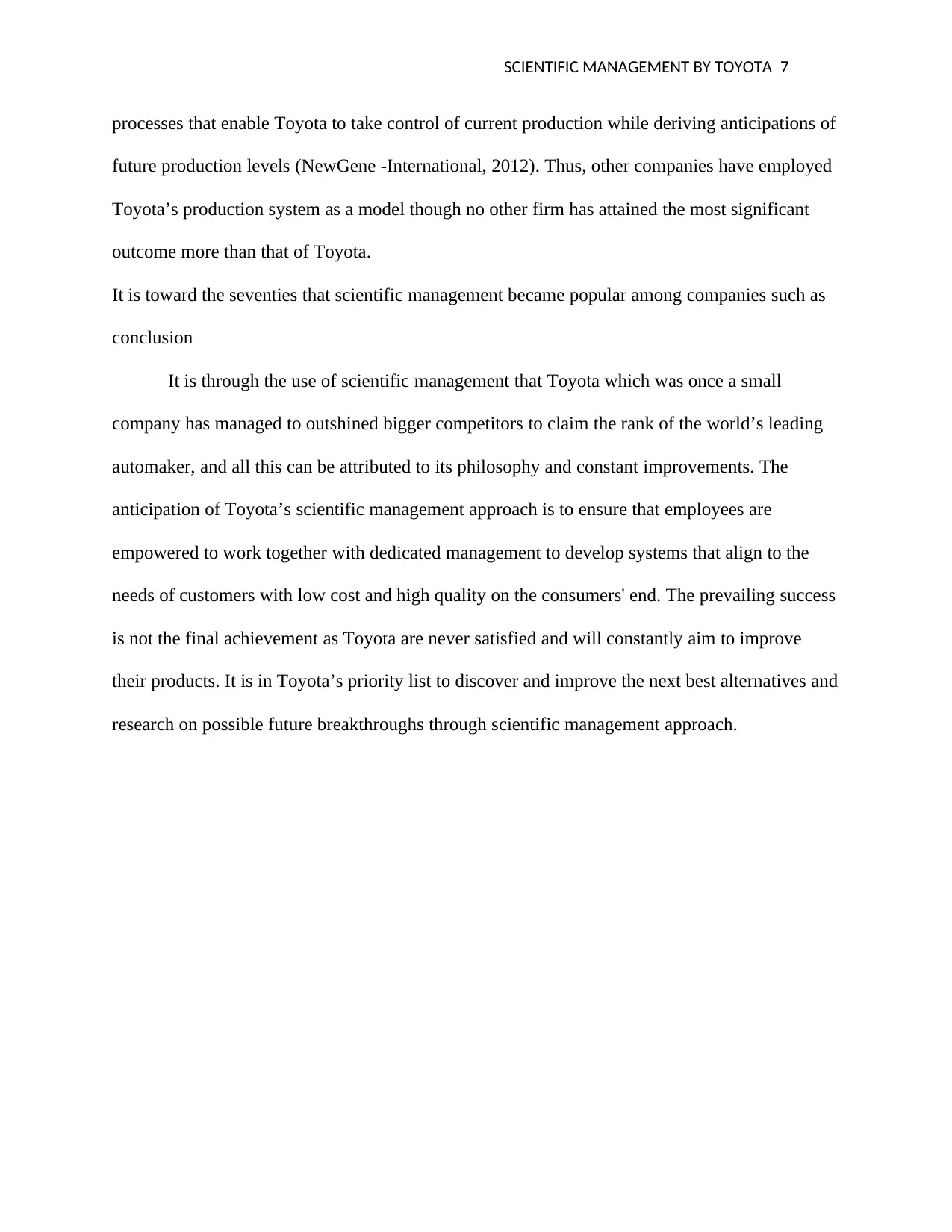
SCIENTIFIC MANAGEMENT BY TOYOTA 7
processes that enable Toyota to take control of current production while deriving anticipations of
future production levels (NewGene -International, 2012). Thus, other companies have employed
Toyota’s production system as a model though no other firm has attained the most significant
outcome more than that of Toyota.
It is toward the seventies that scientific management became popular among companies such as
conclusion
It is through the use of scientific management that Toyota which was once a small
company has managed to outshined bigger competitors to claim the rank of the world’s leading
automaker, and all this can be attributed to its philosophy and constant improvements. The
anticipation of Toyota’s scientific management approach is to ensure that employees are
empowered to work together with dedicated management to develop systems that align to the
needs of customers with low cost and high quality on the consumers' end. The prevailing success
is not the final achievement as Toyota are never satisfied and will constantly aim to improve
their products. It is in Toyota’s priority list to discover and improve the next best alternatives and
research on possible future breakthroughs through scientific management approach.
processes that enable Toyota to take control of current production while deriving anticipations of
future production levels (NewGene -International, 2012). Thus, other companies have employed
Toyota’s production system as a model though no other firm has attained the most significant
outcome more than that of Toyota.
It is toward the seventies that scientific management became popular among companies such as
conclusion
It is through the use of scientific management that Toyota which was once a small
company has managed to outshined bigger competitors to claim the rank of the world’s leading
automaker, and all this can be attributed to its philosophy and constant improvements. The
anticipation of Toyota’s scientific management approach is to ensure that employees are
empowered to work together with dedicated management to develop systems that align to the
needs of customers with low cost and high quality on the consumers' end. The prevailing success
is not the final achievement as Toyota are never satisfied and will constantly aim to improve
their products. It is in Toyota’s priority list to discover and improve the next best alternatives and
research on possible future breakthroughs through scientific management approach.
Paraphrase This Document
Need a fresh take? Get an instant paraphrase of this document with our AI Paraphraser
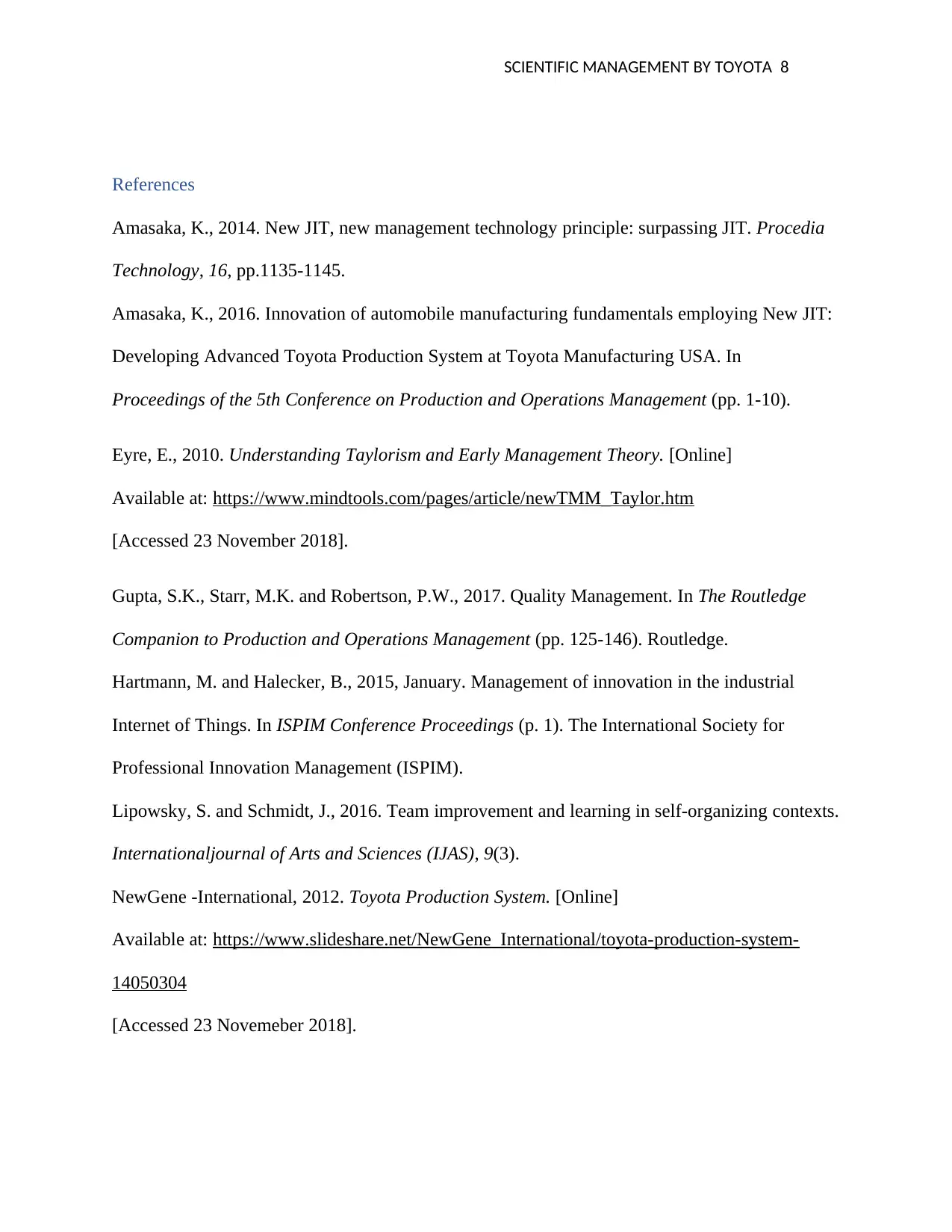
SCIENTIFIC MANAGEMENT BY TOYOTA 8
References
Amasaka, K., 2014. New JIT, new management technology principle: surpassing JIT. Procedia
Technology, 16, pp.1135-1145.
Amasaka, K., 2016. Innovation of automobile manufacturing fundamentals employing New JIT:
Developing Advanced Toyota Production System at Toyota Manufacturing USA. In
Proceedings of the 5th Conference on Production and Operations Management (pp. 1-10).
Eyre, E., 2010. Understanding Taylorism and Early Management Theory. [Online]
Available at: https://www.mindtools.com/pages/article/newTMM_Taylor.htm
[Accessed 23 November 2018].
Gupta, S.K., Starr, M.K. and Robertson, P.W., 2017. Quality Management. In The Routledge
Companion to Production and Operations Management (pp. 125-146). Routledge.
Hartmann, M. and Halecker, B., 2015, January. Management of innovation in the industrial
Internet of Things. In ISPIM Conference Proceedings (p. 1). The International Society for
Professional Innovation Management (ISPIM).
Lipowsky, S. and Schmidt, J., 2016. Team improvement and learning in self-organizing contexts.
Internationaljournal of Arts and Sciences (IJAS), 9(3).
NewGene -International, 2012. Toyota Production System. [Online]
Available at: https://www.slideshare.net/NewGene_International/toyota-production-system-
14050304
[Accessed 23 Novemeber 2018].
References
Amasaka, K., 2014. New JIT, new management technology principle: surpassing JIT. Procedia
Technology, 16, pp.1135-1145.
Amasaka, K., 2016. Innovation of automobile manufacturing fundamentals employing New JIT:
Developing Advanced Toyota Production System at Toyota Manufacturing USA. In
Proceedings of the 5th Conference on Production and Operations Management (pp. 1-10).
Eyre, E., 2010. Understanding Taylorism and Early Management Theory. [Online]
Available at: https://www.mindtools.com/pages/article/newTMM_Taylor.htm
[Accessed 23 November 2018].
Gupta, S.K., Starr, M.K. and Robertson, P.W., 2017. Quality Management. In The Routledge
Companion to Production and Operations Management (pp. 125-146). Routledge.
Hartmann, M. and Halecker, B., 2015, January. Management of innovation in the industrial
Internet of Things. In ISPIM Conference Proceedings (p. 1). The International Society for
Professional Innovation Management (ISPIM).
Lipowsky, S. and Schmidt, J., 2016. Team improvement and learning in self-organizing contexts.
Internationaljournal of Arts and Sciences (IJAS), 9(3).
NewGene -International, 2012. Toyota Production System. [Online]
Available at: https://www.slideshare.net/NewGene_International/toyota-production-system-
14050304
[Accessed 23 Novemeber 2018].
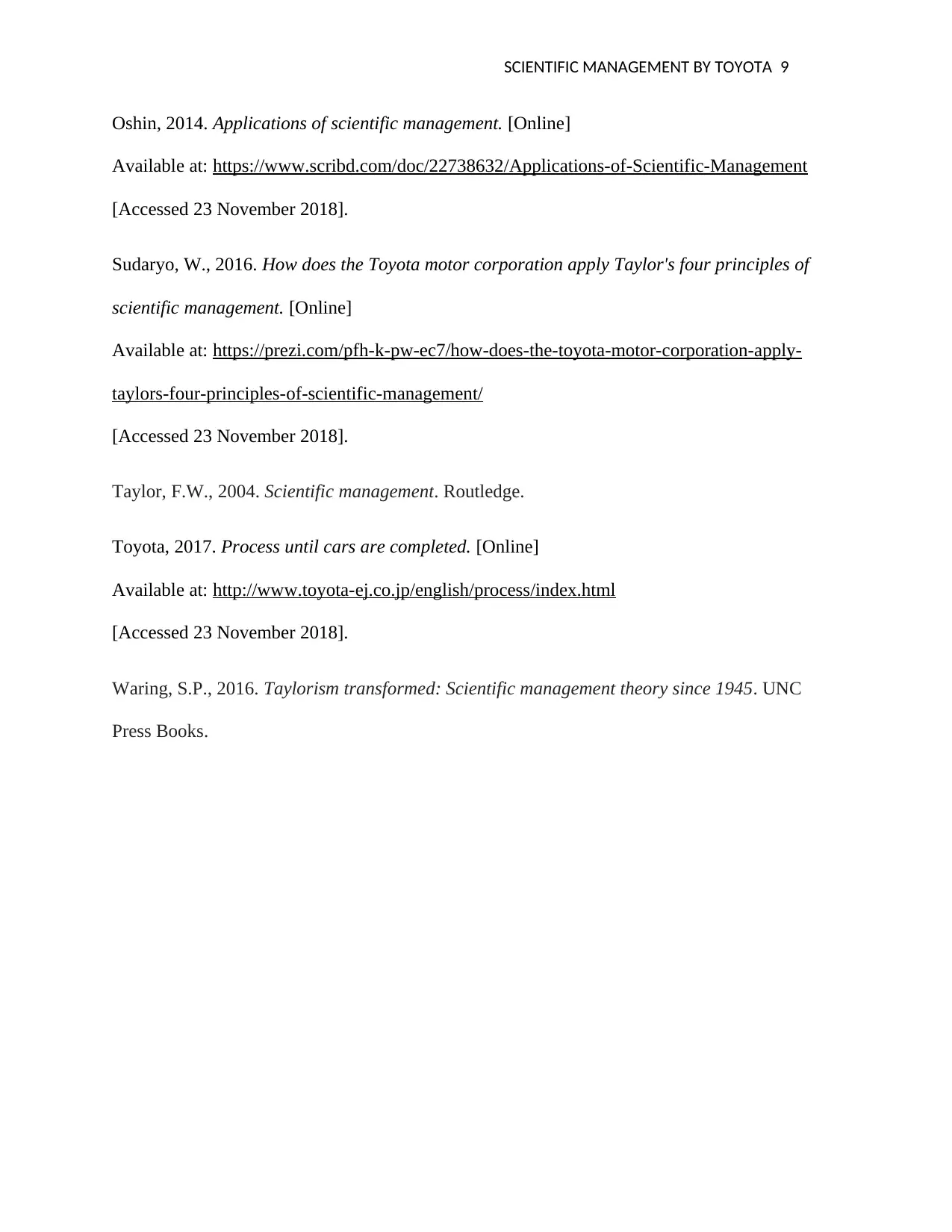
SCIENTIFIC MANAGEMENT BY TOYOTA 9
Oshin, 2014. Applications of scientific management. [Online]
Available at: https://www.scribd.com/doc/22738632/Applications-of-Scientific-Management
[Accessed 23 November 2018].
Sudaryo, W., 2016. How does the Toyota motor corporation apply Taylor's four principles of
scientific management. [Online]
Available at: https://prezi.com/pfh-k-pw-ec7/how-does-the-toyota-motor-corporation-apply-
taylors-four-principles-of-scientific-management/
[Accessed 23 November 2018].
Taylor, F.W., 2004. Scientific management. Routledge.
Toyota, 2017. Process until cars are completed. [Online]
Available at: http://www.toyota-ej.co.jp/english/process/index.html
[Accessed 23 November 2018].
Waring, S.P., 2016. Taylorism transformed: Scientific management theory since 1945. UNC
Press Books.
Oshin, 2014. Applications of scientific management. [Online]
Available at: https://www.scribd.com/doc/22738632/Applications-of-Scientific-Management
[Accessed 23 November 2018].
Sudaryo, W., 2016. How does the Toyota motor corporation apply Taylor's four principles of
scientific management. [Online]
Available at: https://prezi.com/pfh-k-pw-ec7/how-does-the-toyota-motor-corporation-apply-
taylors-four-principles-of-scientific-management/
[Accessed 23 November 2018].
Taylor, F.W., 2004. Scientific management. Routledge.
Toyota, 2017. Process until cars are completed. [Online]
Available at: http://www.toyota-ej.co.jp/english/process/index.html
[Accessed 23 November 2018].
Waring, S.P., 2016. Taylorism transformed: Scientific management theory since 1945. UNC
Press Books.
1 out of 9
Related Documents
Your All-in-One AI-Powered Toolkit for Academic Success.
+13062052269
info@desklib.com
Available 24*7 on WhatsApp / Email
![[object Object]](/_next/static/media/star-bottom.7253800d.svg)
Unlock your academic potential
© 2024 | Zucol Services PVT LTD | All rights reserved.





